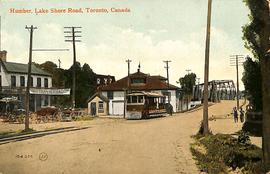This postcard was created and printed by The Valentine & Sons Co., Ltd. Valentine & Sons was a Dundee, Scotland based printing company originally founded in 1825 but did not begin to print postcards until the 1890s. Valentine & Sons first began production of Canadian postcards in 1903 when the company sent a photographer to Montreal. A few years later a Montreal office was formed, followed by offices in Toronto, Vancouver, and Winnipeg. In 1909, the Canadian offices became independent were run under the company name of The Valentine & Sons Publishing Co. Ltd. The first Canadian postcards published by Valentine & Sons were monotone black, collotype postcards featuring photos of scenery along the main line of the Canadian Pacific Railway, north of Lake Superior, as well as scenes in the Rocky Mountains. The tinted halftone and collotype postcards continued to be printed in Great Britain. The main company closed offices in Canada in 1923 but remained focus on printing postcards. (It is important to note that in 1926, the Canadian company split into two: the Toronto-based Valentine Black and the Winnipeg-based Valentine Edy. The two companies continued to reproduce some of the existing images, but Valentine Edy, in particular, adopted new numbering systems in its later years. The Valentine Edy Co. ceased operations in 1957, followed by Valentine Black in 1964.) However, by the 1950s Valentines & Sons, despite the rise of coloured postcards, were producing greeting cards and as a result, the business was struggling. They were eventually purchased by John Waddington & Co. in 1963 and subsequently sold to Hallmark Cards in 1980. In 1994, the Dundee office officially closed.
Typically, Valentine postcards have a 6-digit serial number (###,###) on the view side with the initials “J.V.” in a circle adjacent to that number. The main series of numbering begins with a Halifax card as no. 100,000 and ends (as far as we know) with a postcard of Toronto as no. 115,981. Other relevant codes are the 400,000s and the 600,000s as there are also two short runs of numbers in the 400,000 range that are found on some cards from the Yukon Territory and a longer run of views from various parts of Canada that begins at 600,000 and continues past 602,000. Other countries and areas received various other codes. Typically, the images numbered from the 100,000s through the 105,000s are the most common.
In relation to this postcard, a rough guide was created by The Toronto Postcard Club using a small sample of Valentine & Sons cards. It is important to note that the dates indicated are those of the earliest postmark in the sample. The number on this card is 104,070 which, based on this rough guide, was likely created around July 1909.
This postcard is printed in the half-tone printing style. Half-tone was the cheaper option than the other popular printing method of collotype images. Collotypes was a gelatine-based printing process used between the late 19th and early 20th century to reproduce photographic images on a printing press. These could be left black and white or colourized by directly adding colour to the image. Half-tone prints were cheaper and easier to produce. They are composed of ranges of little dots to create the image. Half-tone prints often look less realistic and “duller”.
«


